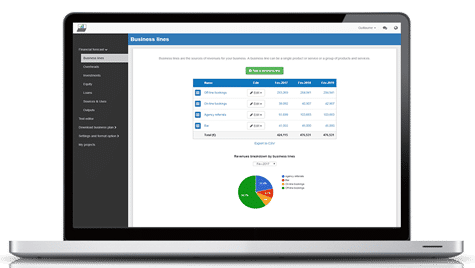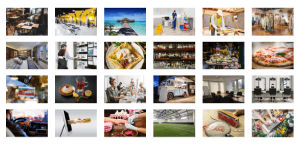How to create a financial forecast for a French restaurant?

Developing and maintaining an up-to-date financial forecast for your French restaurant is key in order to maintain visibility on your business’s future cash flows.
If you feel overwhelmed at the thought of putting together a French restaurant financial forecast then don’t worry as this guide is here to help you.
We'll cover everything from: the main objectives of a financial forecast, the data you need to gather before starting, to the tables that compose it, and the tools that will help you create and maintain your forecast efficiently.
Let's get started!
Why create and maintain a financial forecast for a French restaurant?
In order to prosper, your business needs to have visibility on what lies ahead and the right financial resources to grow. This is where having a financial forecast for your French restaurant becomes handy.
Creating a French restaurant financial forecast forces you to take stock of where your business stands and where you want it to go.
Once you have clarity on the destination, you will need to draw up a plan to get there and assess what it means in terms of future profitability and cash flows for your French restaurant.
Having this clear plan in place will give you the confidence needed to move forward with your business’s development.
Having an up-to-date financial forecast for a French restaurant is also useful if your trading environment worsens, as the forecast enables you to adjust to your new market conditions and anticipate any potential cash shortfall.
Finally, your French restaurant's financial projections will also help you secure financing, as banks and investors alike will want to see accurate projections before agreeing to finance your business.
Need a solid financial forecast?
The Business Plan Shop does the maths for you. Simply enter your revenues, costs and investments. Click save and our online tool builds a three-way forecast for you instantly.
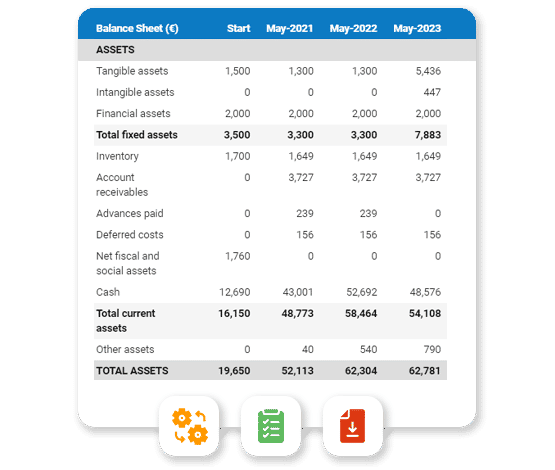
What information is used as input to build a French restaurant financial forecast?
A French restaurant's financial forecast is only as good as the inputs used to build it.
If you are creating (or updating) the forecast of an existing French restaurant, then you mostly need your accounting information, key historical operating non-financial data, and your team’s input on what to expect for the coming years.
If you are building financial projections for a French restaurant startup, you will need to have done your research and have a clear picture of your competitive environment and go-to-market strategy so that you can forecast sales accurately.
For a new venture, you will also need a precise list of the resources needed to keep the French restaurant running on a day-to-day basis and a list of the equipment and expenditures required to start the business (more on that later).
Let's now take a closer look at the elements that make up your French restaurant's financial forecast.
The sales forecast for a French restaurant
From experience, it is usually best to start creating your French restaurant financial forecast by your sales forecast.
To create an accurate sales forecast for your French restaurant, you will have to rely on the data collected in your market research, or if you're running an existing French restaurant, the historical data of the business, to estimate two key variables:
- The average price
- The number of monthly transactions
To get there, you will need to consider the following factors:
- Seasonal ingredients: As a French restaurant, you may use seasonal ingredients in your dishes to ensure the freshest and most authentic flavors. This can affect your prices as the availability and prices of these ingredients may vary throughout the year. Keep track of the prices of your key ingredients and adjust your menu prices accordingly to maintain profitability.
- Tourism season: Depending on the location of your restaurant, you may experience fluctuations in the number of monthly transactions during peak tourist seasons. For example, if your restaurant is located in a popular tourist destination, you may see an increase in customers during the summer months, leading to a higher average price per month. On the other hand, if your restaurant is in a less popular tourist destination, you may see a decrease in transactions during the off-season.
- Competition: The presence of other French restaurants in your area can also impact your average price and number of monthly transactions. If there are many competitors offering similar menus, you may need to adjust your prices to remain competitive and attract customers. Additionally, if a new French restaurant opens in your vicinity, it could potentially affect your sales as customers may choose to try out the new establishment instead.
- Special events: Hosting special events or offering catering services can also impact your average price and number of monthly transactions. For instance, if you host a wine tasting event or offer catering for a wedding, you may see a spike in sales for that particular month. However, it is important to carefully plan and budget for these events to ensure profitability.
- Economic conditions: Economic factors such as inflation and consumer spending can also affect the average price and number of monthly transactions for your French restaurant. During times of economic downturn, customers may prioritize spending on essential goods and services, resulting in a decrease in dining out. On the other hand, during periods of economic growth, consumers may have more disposable income to spend on dining experiences, potentially leading to an increase in transactions and prices.
Once you have an idea of what your future sales will look like, it will be time to work on your overhead budget. Let’s see what this entails.
Need inspiration for your business plan?
The Business Plan Shop has dozens of business plan templates that you can use to get a clear idea of what a complete business plan looks like.
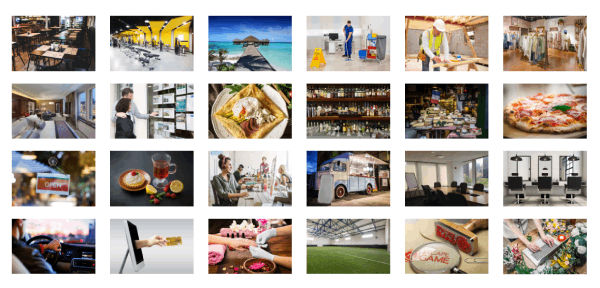
The operating expenses for a French restaurant
The next step is to estimate the expenses needed to run your French restaurant on a day-to-day basis.
These will vary based on the level of sales expected, and the location and size of your business.
But your French restaurant's operating expenses should include the following items at a minimum:
- Staff Costs: This includes salaries, wages, benefits, and training costs for your restaurant staff. As a French restaurant, you may need to hire specialized staff such as French chefs or servers who are fluent in French.
- Food and Beverage Costs: This includes the cost of ingredients, supplies, and beverages used in your restaurant. As a French restaurant, you may need to source high-quality and authentic French ingredients, which can be more expensive.
- Rent: The cost of renting your restaurant space is a significant expense. Make sure to include any additional costs such as utilities, maintenance, and property taxes.
- Accountancy Fees: You may need to hire an accountant to help with bookkeeping, tax preparation, and financial planning for your French restaurant.
- Insurance Costs: This includes general liability insurance, property insurance, and workers' compensation insurance for your restaurant.
- Marketing and Advertising: To attract customers to your French restaurant, you may need to invest in marketing and advertising strategies such as social media, print ads, and event sponsorships.
- Utilities: This includes the cost of electricity, gas, water, and other utilities needed to run your restaurant.
- Software Licenses: As a French restaurant, you may need specialized software for menu planning, reservations, and inventory management.
- Banking Fees: This includes transaction fees, monthly account fees, and credit card processing fees for your restaurant's banking needs.
- Repairs and Maintenance: Restaurants require frequent repairs and maintenance, from equipment repairs to furniture replacements.
- Waste Disposal: Proper waste disposal is essential for the smooth operation of your French restaurant. This includes garbage collection, recycling, and composting services.
- Licenses and Permits: You may need to obtain various licenses and permits to run your French restaurant, such as a liquor license or health permit.
- Training and Development: As a French restaurant, it's crucial to invest in training and development programs for your staff to maintain high-quality standards and keep up with industry trends.
- Taxes: Don't forget to include taxes, such as income tax, sales tax, and payroll tax, in your operating expenses forecast.
- Professional Fees: This includes fees for legal services, consulting services, and other professional services that your restaurant may require.
This list is, of course, not exhaustive, and you'll have to adapt it according to your precise business model and size. A small French restaurant might not have the same level of expenditure as a larger one, for example.
What investments are needed to start or grow a French restaurant?
Your French restaurant financial forecast will also need to include the capital expenditures (aka investments in plain English) and initial working capital items required for the creation or development of your business.
For a French restaurant, these could include:
- Kitchen Equipment: This includes items such as stoves, ovens, refrigerators, and other appliances needed to prepare and store food. These are essential for any French restaurant, as French cuisine requires specific equipment for cooking techniques such as sous vide and flambé.
- Furniture and Decor: French restaurants often have a specific aesthetic with elegant and traditional furniture, such as wooden tables and chairs, and decorative elements such as chandeliers and artwork. These items not only create a welcoming ambiance but also contribute to the overall French dining experience.
- Wine Cellar: A French restaurant is incomplete without a well-stocked wine cellar. This includes wine racks, temperature control systems, and other equipment needed to properly store and serve various types of wine. A high-quality wine selection is crucial for a French restaurant's success.
- Tableware and Linens: French cuisine is known for its attention to detail, and this extends to the presentation of the food. This is why high-quality tableware, such as elegant plates, bowls, and cutlery, and luxurious linens, are essential for a French restaurant. These items not only enhance the dining experience but also reflect the restaurant's commitment to excellence.
- Renovations and Improvements: French restaurants often have a long history and are located in historic buildings. As such, renovations and improvements may be necessary to maintain the restaurant's charm and functionality. This could include updates to the kitchen, dining area, or outdoor space, as well as repairs to any structural or aesthetic elements.
Again, this list will need to be adjusted according to the size and ambitions of your French restaurant.
Need a convincing business plan?
The Business Plan Shop makes it easy to create a financial forecast to assess the potential profitability of your projects, and write a business plan that’ll wow investors.
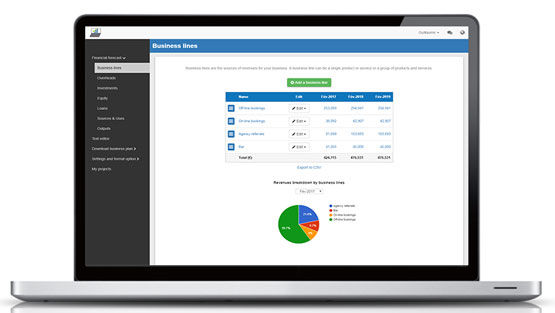
The financing plan of your French restaurant
The next step in the creation of your financial forecast for your French restaurant is to think about how you might finance your business.
You will have to assess how much capital will come from shareholders (equity) and how much can be secured through banks.
Bank loans will have to be modelled so that you can separate the interest expenses from the repayments of principal, and include all this data in your forecast.
Issuing share capital and obtaining a bank loan are two of the most common ways that entrepreneurs finance their businesses.
What tables compose the financial plan for a French restaurant?
Now let's have a look at the main output tables of your French restaurant's financial forecast.
The projected profit & loss statement
The projected profit & loss shows how profitable your French restaurant is likely to be in the years to come.
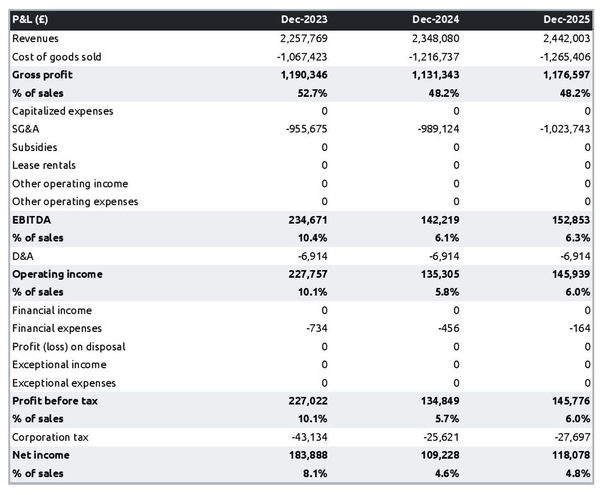
For your French restaurant to be financially viable, your projected P&L should ideally show:
- Sales growing above inflation (the higher the better)
- Profit margins which are stable or expanding (the higher the better)
- A net profit at the end of each financial year (the higher the better)
This is for established French restaurants, there is some leniency for startups which will have numbers that will look a bit different than existing businesses.
The projected balance sheet
The projected balance sheet gives an overview of your French restaurant's financial structure at the end of the financial year.
It is composed of three categories of items: assets, liabilities and equity:
- Assets: are what the business possesses and uses to produce cash flows. It includes resources such as cash, buildings, equipment, and accounts receivable (money owed by clients).
- Liabilities: are the debts of your French restaurant. They include accounts payable (money owed to suppliers), taxes due and bank loans.
- Equity: is the combination of what has been invested by the business owners and the cumulative profits to date (which are called retained earnings). Equity is a proxy for the value of the owner's stake in the business.
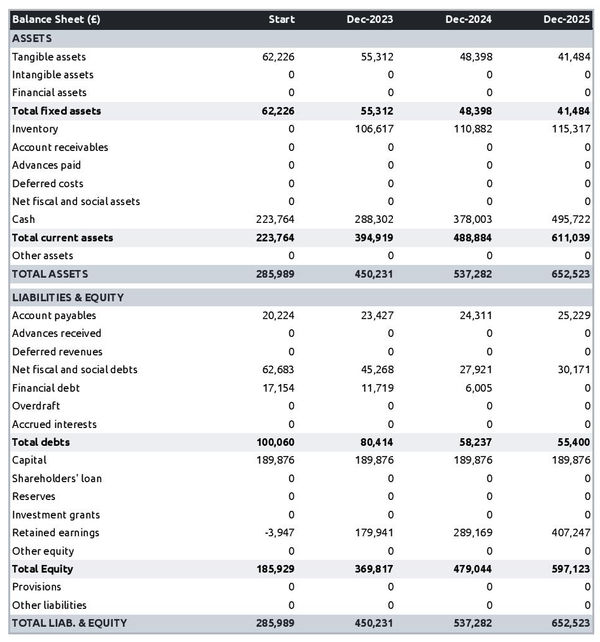
The cash flow projection
The cash flow forecast of your French restaurant will show how much cash the business is expected to generate or consume over the next three to five years.

There are multiple ways of presenting a cash flow forecast but from experience, it is better to organise it by nature in order to clearly show these elements:
- Operating cash flow: how much cash is generated by the French restaurant's operations
- Investing cash flow: what is the business investing to expand or maintain its equipment
- Financing cash flow: is the business raising additional funds or repaying financiers (debt repayment, dividends)
Your cash flow forecast is the most important element of your overall financial projection and that’s where you should focus your attention to ensure that your French restaurant is adequately funded.
Note: if you are preparing a financial forecast in order to try to secure funding, you will need to include both a yearly and monthly cash flow forecast in your French restaurant's financial plan.
Need a solid financial forecast?
The Business Plan Shop does the maths for you. Simply enter your revenues, costs and investments. Click save and our online tool builds a three-way forecast for you instantly.

Which tool should you use to create your French restaurant's financial projections?
Building a French restaurant financial forecast is not difficult provided that you use the right tool for the job. Let’s see what options are available below.
Using online financial forecasting software to build your French restaurant's projections
The modern and easiest way is to use an online financial forecasting tool such as the one we offer at The Business Plan Shop.
There are several advantages to using specialised software:
- You can easily create your financial forecast by letting the software take care of the financial calculations for you without errors
- You have access to complete financial forecast templates
- You get a complete financial forecast ready to be sent to your bank or investors
- You can easily track your actual financial performance against your financial forecast, and recalibrate your forecast as the year goes by
- You can create scenarios to stress test your forecast's main assumptions
- You can easily update your forecast as time goes by to maintain visibility on future cash flows
- You have a friendly support team on standby to assist you when you are stuck
- It’s cost-efficient and much cheaper than using an accountant or consultant (see below)
If you are interested in this type of solution, you can try our projection software for free by signing up here.
Hiring a financial consultant or chartered accountant
Hiring a consultant or chartered accountant is also an efficient way to get a professional French restaurant financial projection.
As you can imagine, this solution is much more expensive than using software. From experience, the creation of a simple financial forecast over three years (including a balance sheet, income statement, and cash flow statement) is likely to start around £700 or $1,000 excluding taxes.
The indicative estimate above, is for a small business, and a forecast done as a one-off. Using a financial consultant or accountant to track your actuals vs. forecast and to keep your financial forecast up to date on a monthly or quarterly basis will naturally cost a lot more.
If you choose this solution, make sure your service provider has first-hand experience in your industry, so that they may challenge your assumptions and offer insights (as opposed to just taking your figures at face value to create the forecast’s financial statements).
Why not use a spreadsheet such as Excel or Google Sheets to build your French restaurant's financial forecast?
You and your financial partners need numbers you can trust. Unless you have studied finance or accounting, creating a trustworthy and error-free French restaurant financial forecast on a spreadsheet is likely to prove challenging.
Financial modelling is very technical by nature and requires a solid grasp of accounting principles to be done without errors. This means that using spreadsheet software like Excel or Google Sheets to create accurate financial forecasts is out of reach for most business owners.
Creating forecasts in Excel is also inefficient nowadays:
- Software has advanced to the point where forecasting can be done much faster and more accurately than manually on a spreadsheet.
- With artificial intelligence, the software is capable of detecting mistakes and helping decision-making.
Spreadsheets are versatile tools but they are not tailor-made for reporting. Importing your French restaurant's accounting data in Excel to track actual vs. forecast is incredibly manual and tedious (and so is keeping forecasts up to date). It is much faster to use dedicated financial planning tools like The Business Plan Shop which are built specially for this.
Need a convincing business plan?
The Business Plan Shop makes it easy to create a financial forecast to assess the potential profitability of your projects, and write a business plan that’ll wow investors.

Use our financial projection templates for inspiration
The Business Plan Shop has dozens of financial forecast templates available.
Our examples contain a complete business plan with a financial forecast and a written presentation of the company, the team, the strategy, and the medium-term objectives.
Whether you are just starting out or already have your own French restaurant, looking at our financial forecast template is a good way to:
- Understand what a complete business plan should look like
- Understand how you should model financial items for your French restaurant
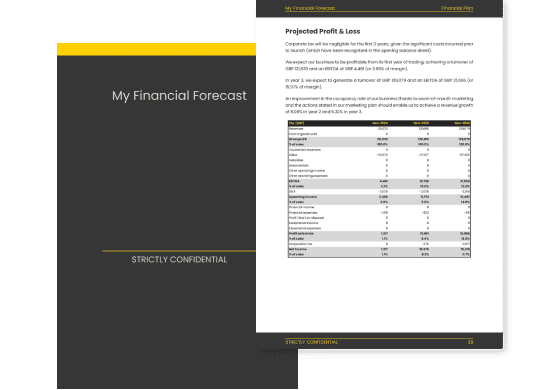
Takeaways
- Having a financial forecast enables you to visualise the expected growth, profitability, and cash generation for your business over the next three to five years.
- Tracking actuals vs. forecast and keeping your financial projections up-to-date is the only way to get a view on what your French restaurant future cash flows may look like.
- Using financial forecasting software is the mordern and easy way to create and maintain your forecasts.
This is the end of our guide on how to build the financial forecast for a French restaurant, we hope you found it useful. Don't hesitate to contact us if you want to share your feedback or have any questions.
Need inspiration for your business plan?
The Business Plan Shop has dozens of business plan templates that you can use to get a clear idea of what a complete business plan looks like.

Also on The Business Plan Shop
Know someone who owns or is thinking of starting a French restaurant? Share our forecasting guide with them!

